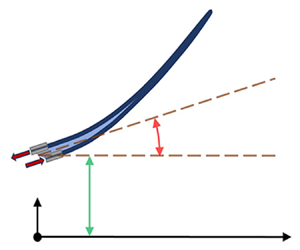No CrossRef data available.
Article contents
Effects of antagonistic muscle actuation on the bilaminar structure of ray-finned fish in propulsion
Published online by Cambridge University Press: 16 November 2023
Abstract

In this study, the effects of antagonistic muscle actuation on the propulsion of a bilaminar-structure fish fin ray were investigated using a two-dimensional computational flow–structure interaction (FSI) model. The structure and material properties of the model were based on the realistic biological data of the sunfish fin. The effect of muscle actuation was modelled using root displacement offset between the two hemitrichs. Parametric FSI simulations were conducted by assuming a sinusoidal function of the offset over a cycle and varying the amplitude and phase difference between the actuations and pitching/plunging motions. The results show that the phase of muscle actuation is a critical factor affecting its effects. Three performance regions can be identified with different phase ranges, including a thrust-favour region, an efficiency-favour region and a thrust-efficiency-unfavour region. In each region, the relationships among the root actuations, fin-ray kinematics, vortex dynamics and resulting performance are studied and discussed. Furthermore, a strong positive correlation between the trailing–leading amplitude ratio and thrust coefficient as well as a negative relationship between the efficiency and angle of attack at the centre of mass of the fin ray are observed.
JFM classification
- Type
- JFM Papers
- Information
- Copyright
- © The Author(s), 2023. Published by Cambridge University Press





